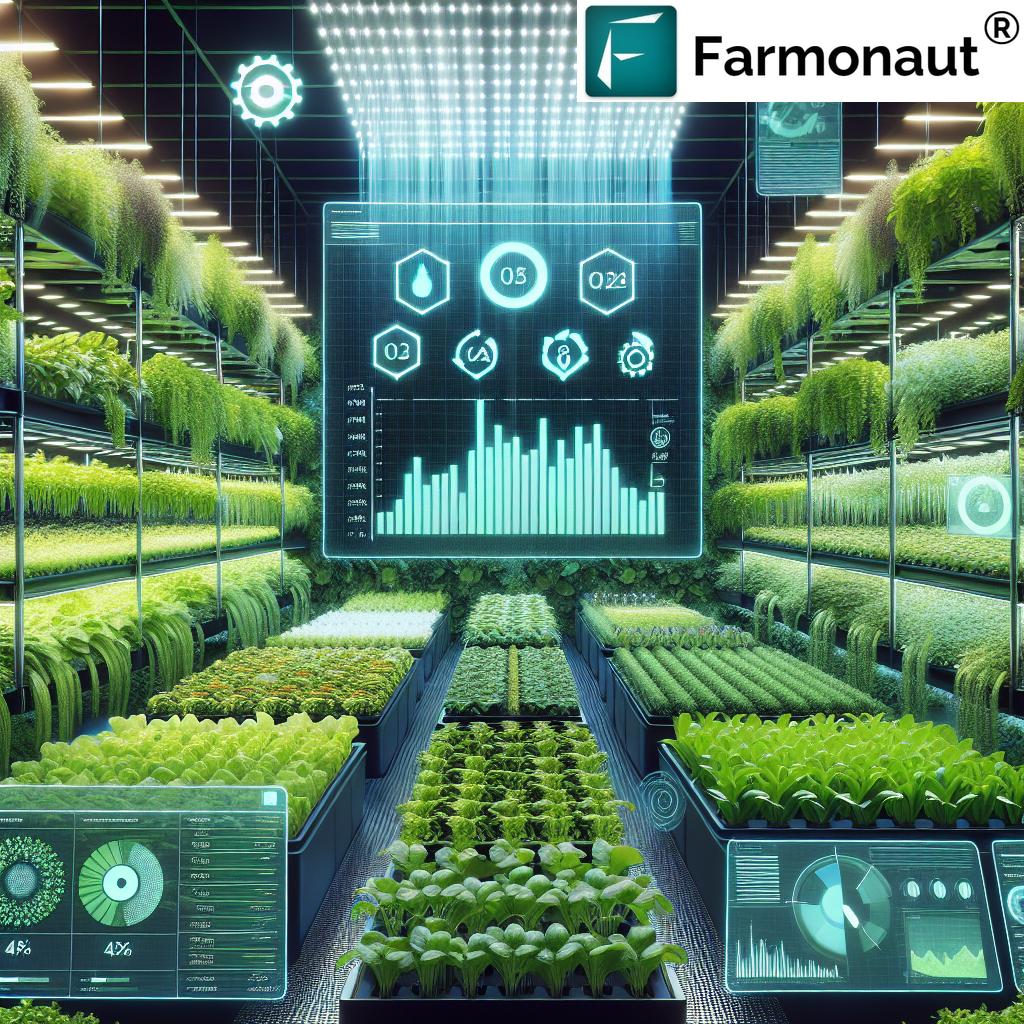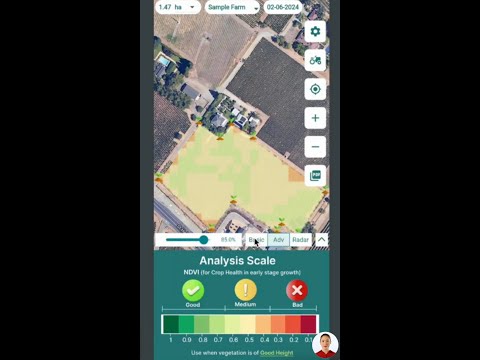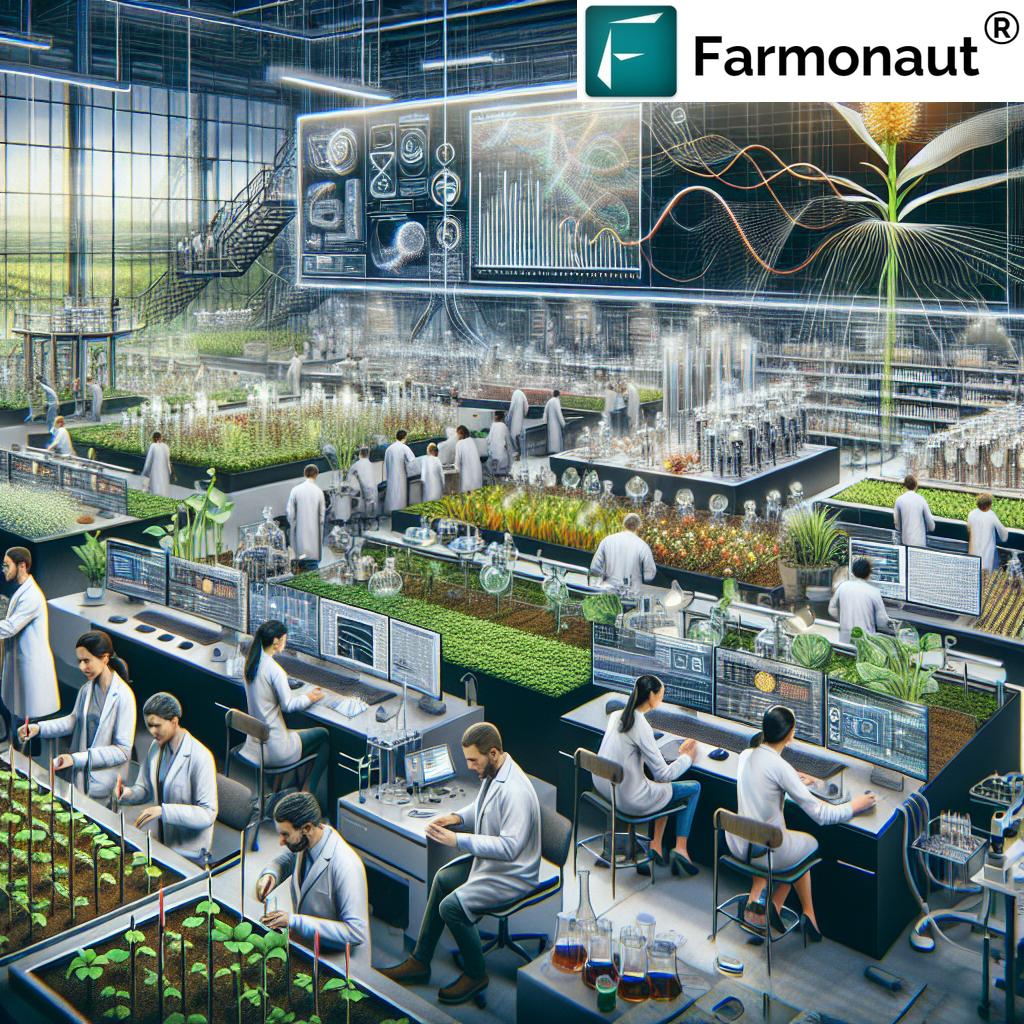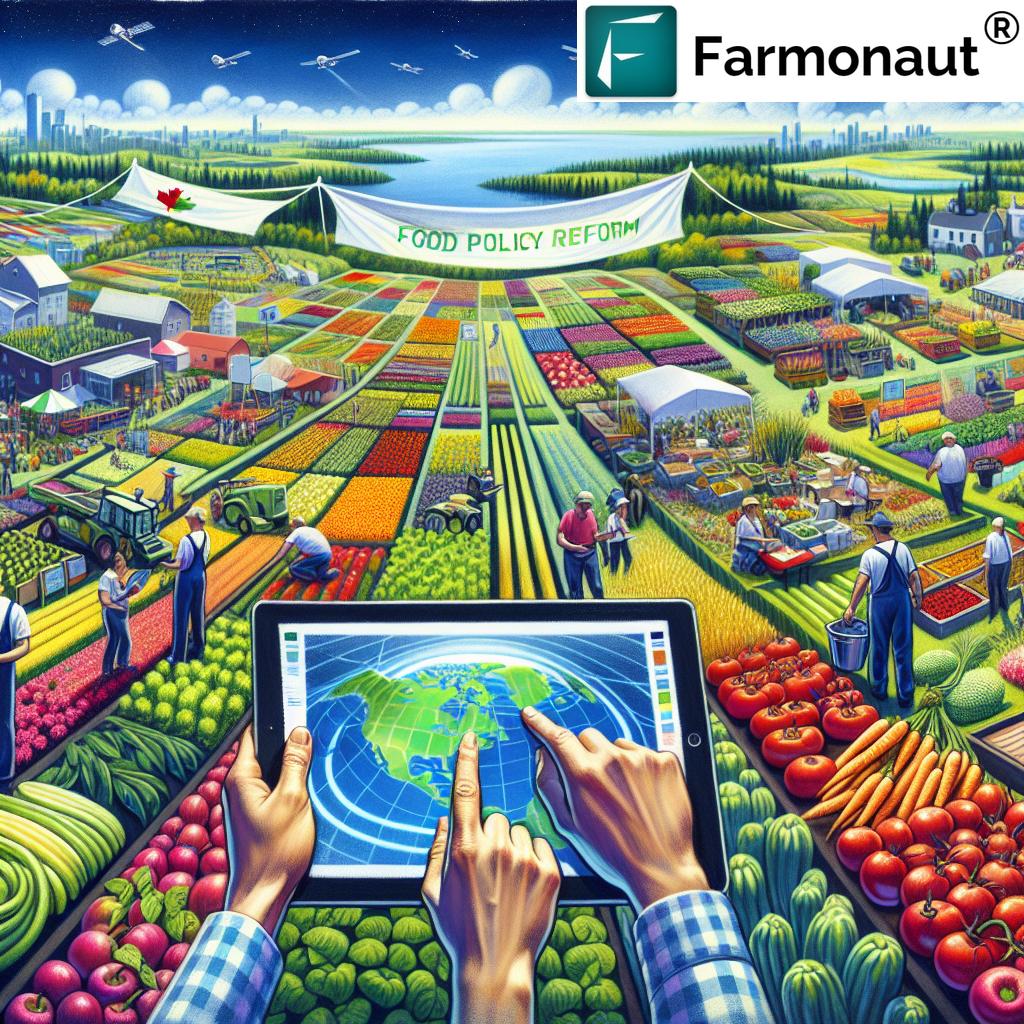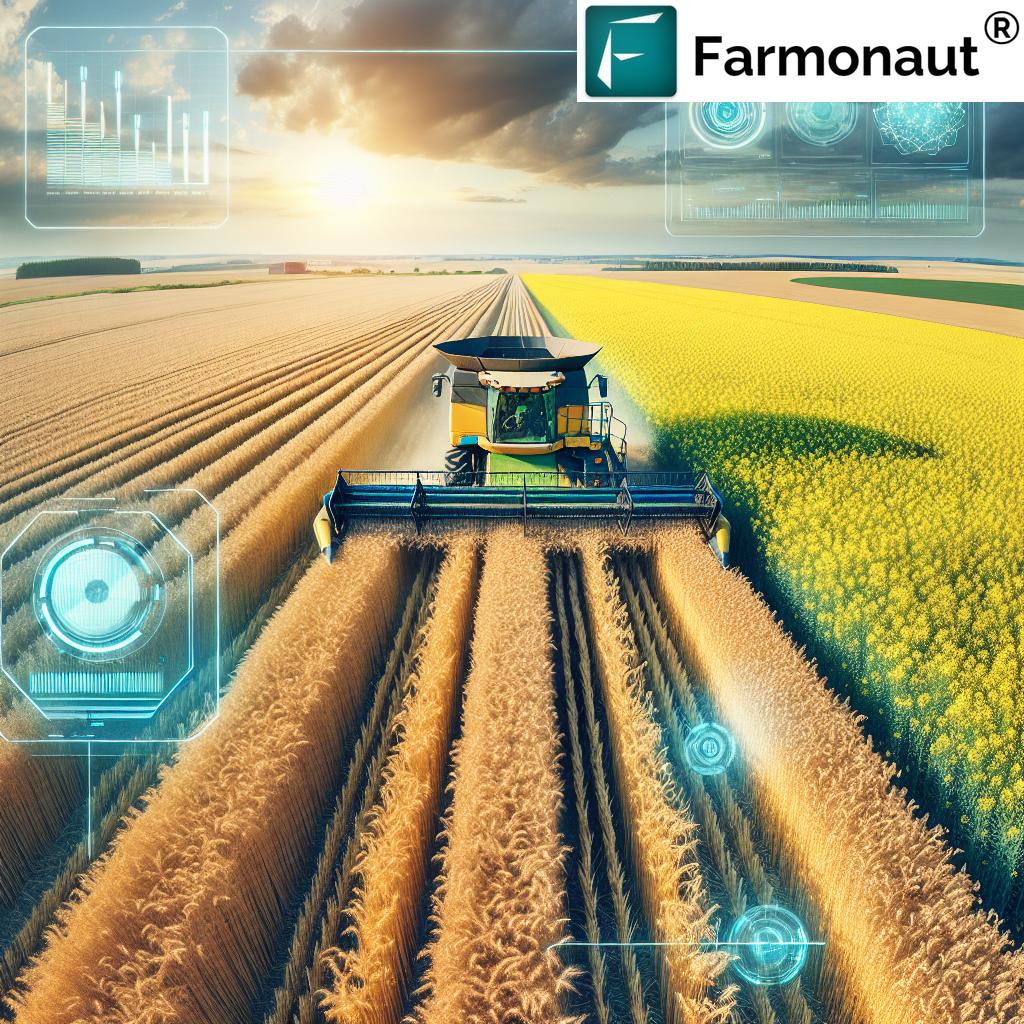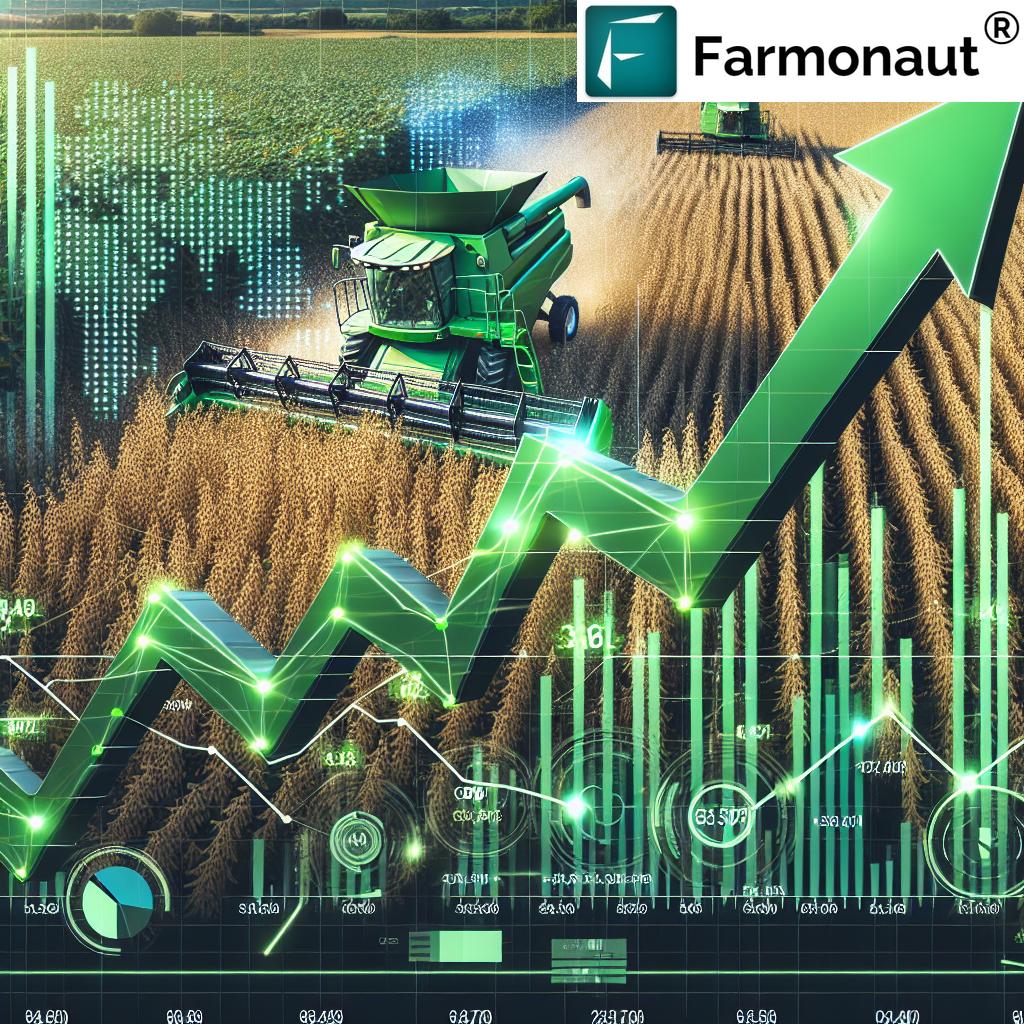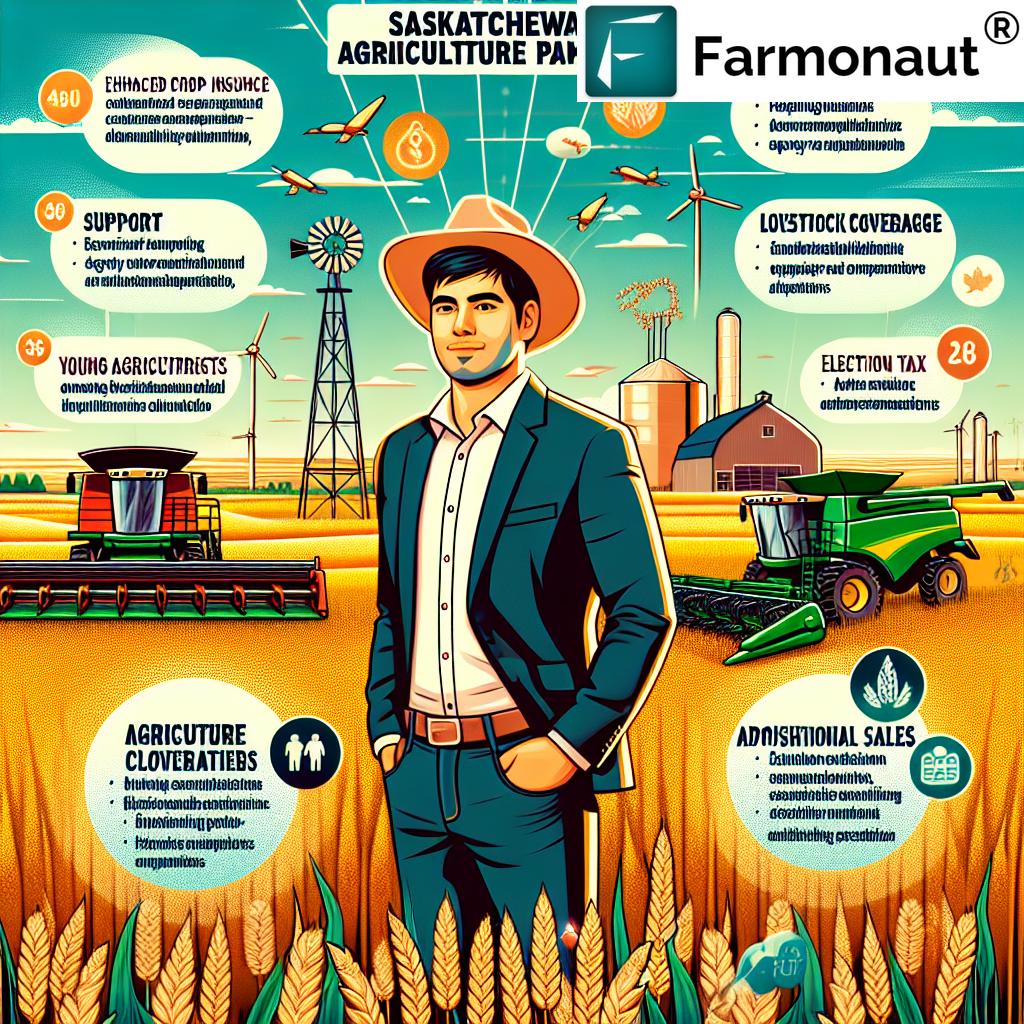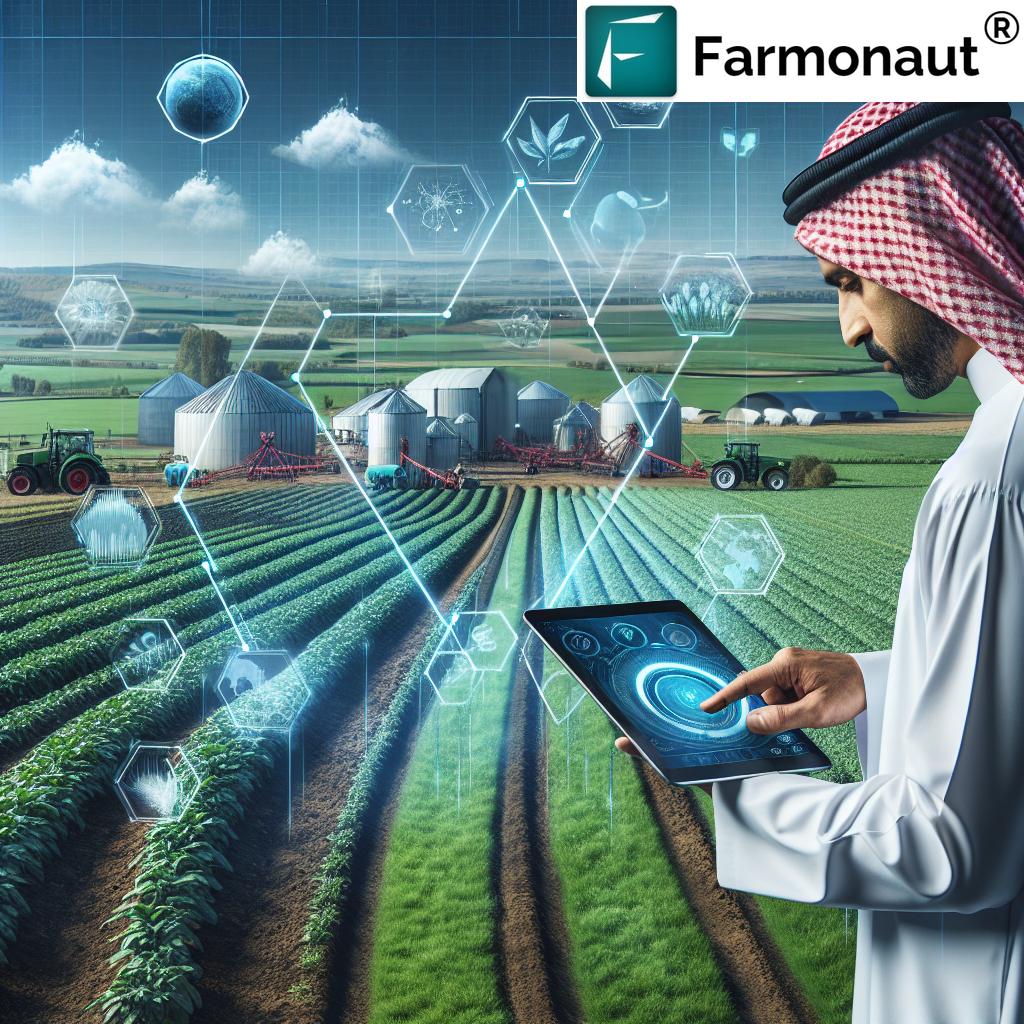Table of Contents
- Introduction
- Global AgTech Funding 2024: A Snapshot
- Current State of AgTech Funding
- Key AgTech Funding & Investment Trends
- AgTech Investment Trends Comparison Table
- Challenges in Securing AgTech Funding in 2024
- Impact of Capital Drought on AgTech Startups
- Notable AgTech Funding Rounds 2024
- Farmonaut’s Precision Agriculture Solutions
- The Future of AgTech: Outlook and Opportunities
- FAQ: AgTech Funding 2024 & Innovations
- Farmonaut Subscriptions
- Conclusion: Shaping the Next Generation of Agriculture
“Global AgTech funding surpassed $20 billion in 2024, marking a 15% increase from the previous year.”
AgTech Funding 2024: Powerful Trends Shaping Agriculture
The transformation of agriculture through technological innovation is in full swing, with AgTech standing front and center. Today, we find ourselves in an era where funding for agricultural technology, strategic investment, and evolving startups are driving rapid change across the sector. By integrating advanced technologies like artificial intelligence (AI), the Internet of Things (IoT), and modern biotechnology, the global agricultural community is embracing a shift towards sustainable farming practices, climate resilience, and optimal resource management.
In this comprehensive article, we dive deep into AgTech funding in 2024, analyzing the latest trends, investment patterns, and the innovative solutions propelling the future of agriculture. We’ll explore the sectors attracting the most capital, spotlight key technologies such as precision agriculture, and outline how companies like Farmonaut are making AI in farming accessible globally. Whether you’re an investor, policymaker, agribusiness leader, or farmer, this guide offers critical insights for anyone interested in agricultural technology investment and the quest for food security and sustainability.
Focus Keywords: AgTech funding, agricultural technology investment, precision agriculture solutions, sustainable farming practices, agtech startups 2024, venture capital in agriculture, AI in farming, agricultural biotechnology trends, indoor farming technology, climate-smart agriculture
Global AgTech Funding 2024: A Snapshot
Let’s start by placing AgTech funding in context. Despite recent market turbulence, the global AgTech sector remains vibrant: in 2023, investments reached an estimated $29.6 billion, a testament to the mounting urgency around challenges like climate change, food security, and sustainable development (source). This increase reflects the evolving perception of agriculture as a hub of technological opportunity.
- Regionally, North America and Europe remain the leading sources and destinations for AgTech investment, with Asia-Pacific markets increasingly in focus for future growth.
- Government and institutional support are contributing critical funding, alongside a strong – though recently challenged – stream of venture capital (VC).
- Sectors like precision agriculture solutions, indoor farming, AgBioTech, and sustainable inputs like biologicals, attract the lion’s share of capital.
What does this mean for agriculture, and how will these trends shape the sector going forward? We explore these questions in detail below.
Current State of AgTech Funding: Trends and Challenges in 2024
We’ve seen both optimism and caution mark the state of AgTech funding in 2024. After consecutive years of growth, the sector experienced a notable downturn:
- Venture capital investment in AgTech declined by 30% year-over-year, largely impacting early-stage rounds and slowing new startup formation. (source)
- Early-stage investments saw the sharpest drop, with a 33.7% decrease, signaling hesitancy among investors toward unproven solutions (source).
- Despite this, mature AgTech companies continued to secure sizable funding—especially those focused on proven, scalable precision agriculture solutions and climate-smart agriculture.
Several factors stand out:
- Macroeconomic pressures influencing risk appetite among investors
- Ongoing R&D costs and long product development cycles, unique to the agricultural technology sector
- Migration of some firms toward non-traditional funding sources, such as grants, crowdfunding, and strategic partnerships
Nevertheless, precision agriculture, advanced robotics, and digital solutions for supply chain transparency—like those offered by Farmonaut (Blockchain-Based Traceability)—continue to spark investment interest. These technologies provide sustainable practices to manage costs, boost yields, and address urgent climate challenges.
“Precision agriculture solutions attracted over 30% of total AgTech investments, highlighting a shift towards data-driven farming.”
Key AgTech Funding & Investment Trends: Where is Capital Flowing?
The AgTech sector is not homogenous—different segments attract variable interest and capital. Let’s break down 2024’s top agricultural technology investment trends:
-
Precision Agriculture: Data, Automation, and Advanced Sensing
Precision agriculture solutions are reshaping traditional farming by using AI, satellite imagery, robotics, and the Internet of Things (IoT) to optimize crop management and boost yields. Investors are captivated by startups enabling farmers to enhance efficiency, conserve resources, and reduce environmental impact.
- Main focuses: Remote crop health monitoring, variable rate technology, drone applications, automated machinery.
- Opportunities: Affordable platforms (like large-scale farm management tools), real-time decision support, and data-driven farm automation.
Example: Farmonaut democratizes satellite-based precision agriculture by delivering NDVI analysis, soil moisture monitoring, and AI-based advisory via mobile, web, and API.
-
Agricultural Biotechnology (AgBioTech): Editing the Future
Agricultural biotechnology trends are advancing quickly, with nearly $2B in funding in 2024. Gene editing technologies (including CRISPR) and innovative crop traits—such as pest resistance and higher yield—are attracting strategic corporate and VC funding.
- Key areas: Genome editing, biotech seeds, pest and drought resistance, bioengineered fertilizers.
- Farmonaut’s advisory services help maximize benefit from biotech crops by providing real-time, personalized recommendations for crop and plantation management.
-
Indoor Farming Technology: Next-Gen Urban & Controlled Environment Agriculture
Indoor farming technology—including vertical farms and plant factories—has changed its funding narrative. After 2021’s highs, investment retreated by 83.5%, shifting focus to operational viability and long-term scale.
- Current focus: Reducing production costs, energy efficiency, automation, integration with AI and robotics.
- Why it matters: Controlled environments mitigate climate impacts, support urban agriculture, and enable year-round food supply.
-
Regenerative & Sustainable Agriculture: Funding Climate-Smart Agriculture
Sustainable farming practices that improve soil, reduce carbon emissions, and enable organic production are catching significant investor attention. This wave includes carbon credit markets, biopesticides, and real-time carbon tracking—a growing necessity for farm businesses navigating climate-related regulations.
- Major draw: Impact investing and government grants supporting climate-smart agriculture and sustainable inputs.
- Farmonaut’s edge: Carbon footprinting solutions enable agribusinesses to track and reduce CO2 output with actionable satellite data, aligning with global sustainability initiatives.
-
Alternative Proteins & Food Tech Innovations
Alternative proteins—plant-based, lab-grown meats, and fermentation-based food innovations—are seeing massive investment momentum. Consumer preferences, resource efficiency, and climate mitigation benefits drive investor focus.
- Growth drivers: Expanded R&D, regulatory approvals, and rising partnerships with food companies for product scale-up.
- Future outlook: This segment ties back to sustainable farming by reducing livestock emissions and land pressure.
AgTech Investment Trends Comparison Table
| Segment Name | Estimated Global Funding in 2024 (USD Billion) | Year-on-Year Growth Rate (%) | Notable Innovations/Technologies | Leading Regions |
|---|---|---|---|---|
| Precision Agriculture | $8.9 | +12% | AI-powered field monitoring, IoT sensors, satellite imagery (Farmonaut), drone-based crop inputs | North America, EU, India, China |
| Robotics & Automation | $4.3 | +8% | Autonomous tractors/drones, robotic weeders, harvesters, AI-guided machinery | USA, Western Europe, Japan |
| Farm Management Software | $3.7 | +7% | Satellite-based platforms (Farmonaut Admin App), weather data integration, analytics APIs | Global |
| Sustainable Inputs & AgBioTech | $6.1 | +17% | CRISPR gene editing, biofertilizers/pesticides, crop trait improvements | USA, China, Israel, Netherlands |
| Indoor Farming/Controlled Environment | $2.2 | -11% | Hydroponics, aeroponics, energy-efficient light, automation | Japan, USA, Singapore, UAE |
As our table shows, Precision agriculture solutions—from AI-powered crop health diagnostics to satellite-enabled farm management—lead the funding race, followed by biotechnology and robotics. Regional patterns shift as climate concerns, regulatory incentives, and technological readiness vary.
Challenges in Securing AgTech Funding in 2024
As the AgTech funding climate cools, there are substantial obstacles for both new entrants and established startups:
- High R&D Costs: Advanced agricultural solutions—especially those reliant on AI, IoT, or gene editing—require heavy upfront investment. Extended testing cycles and regulatory hurdles raise capital needs.
- Longer Time to Market: Unlike digital-only startups, AgTech teams need time for field testing, validation, and farmer feedback before scaling.
- Complex Regulatory Environment: Biotechnology, chemical, and data-centric products must navigate diverse global standards.
- Farmer Adoption Barriers: Traditional farmers may resist change due to high perceived costs, complex user interfaces, or learning curves.
- Fragmented Markets: Smallholder-dominant regions, varying land sizes, and diverse ecosystems require tailored solutions—which slows global scalability.
Tools like Farmonaut’s satellite-based farm management (web/mobile app), which leverage remote sensing with no additional hardware, are lowering these barriers. Flexible subscription models and affordable APIs (API Docs) help startups and agribusinesses alike adopt precision agriculture without overwhelming upfront costs.
Impact of Capital Drought on AgTech Startups in 2024
The sudden drop in venture capital in agriculture has left many AgTech startups facing survival challenges:
- Layoffs & Downsizing: Headcount and operational costs are being cut, slowing rollout of solutions vital for food and climate resilience.
- Paused Product Development: Many teams slow or halt R&D activities, delaying innovations in crucial fields such as pest control, crop genetics, and robotics.
- Bankruptcy Risk: Several early-stage companies have shut down due to inability to secure further rounds. More are pivoting, consolidating, or seeking government grants.
- Rise of Alternative Funding: With venture capital selective, many turn to crowdfunding, institutional grants, and productization of their technology stack.
The message is clear: to survive, startups must demonstrate not just technical promise but also near-term scalability and real-world adoption, especially in precision agriculture solutions, digital management tools, and climate adaptation technologies.
Notable AgTech Funding Rounds 2024: Who’s Raising and Why?
Even in a capital-stressed market, standout companies in agricultural technology secured impressive funding rounds, validating their models and underscoring key investment trends:
-
Oishii
- Raised $150 million (Series B)—Accelerating international expansion of its indoor vertical farming platform, emphasizing sustainable, year-round supply.
-
Monarch Tractor
- Secured $133 million (Series C)—Developed fully electric, autonomous tractors; robots adapted for mid-size farms to enhance efficiency and reduce labor costs.
-
Inari
- Achieved $103 million (Funding)—Investing in AI-driven crop science to boost yield, sustainability, and adaptability in staple crops.
-
Carbon Robotics
- Raised $70 million (Series D)—Expanding AI-powered weeding technologies to reduce herbicide use and operational costs for farmers worldwide.
These funding rounds reinforce that proven AI-driven, robotics, and controlled-environment platforms still attract robust support—especially those aligned with climate-smart agriculture and sustainable growth goals.
Farmonaut’s Precision Agriculture Solutions and Value Proposition
As new funding tightens, scalable, proven solutions are more essential than ever. Farmonaut is at the heart of this shift—delivering key services that directly counteract the obstacles facing startups, agribusinesses, and institutional users globally.
Farmonaut’s Technology Stack
- Satellite-Based Crop Health Monitoring: Access to NDVI/NDRE maps, soil moisture insights, and early pest/disease warnings without the need for in-field hardware; improves yield and reduces wasted resources. Empower your sustainability journey with Farmonaut’s carbon footprinting tool for emissions tracking.
- Jeevn AI Advisory System: Personalized, AI-driven crop management that delivers actionable recommendations. This helps optimize input costs, foster sustainable farming practices, and improve farm productivity.
- Blockchain-Based Product Traceability: Ensures transparent, verifiable farm-to-fork journeys—augments credibility for agribusinesses, food supply chains, and export-oriented producers (Traceability).
- Fleet & Resource Management: Efficiency tools for managing agricultural fleets—scheduling, tracking, and optimizing vehicle/machinery use to reduce operational costs. Discover more at fleet management.
- API and Developer Integration: Farmonaut’s satellite/weather API (API Developer Docs) supports custom solutions and third-party applications, extending the reach of its agri-data backbone.
- Financial Access: By offering satellite-based crop verification (crop loan and insurance), Farmonaut accelerates loan approvals and insurance claims, reducing risks for both farmers and institutions.
These technologies drive measurable gains:
- Cost-effective solutions—Precision farming without expensive hardware, suitable for all scales of agriculture
- Scalable for individuals, enterprises, and governments—With flexible subscriptions and API-based access
- Empowering sustainable farming through resource efficiency, carbon reduction, and improved decision-making
Key Farmonaut Value Propositions:
- Accessible & modular solutions for all farmer types and agribusiness scales
- Real-time monitoring: NDVI, soil, water status, operational metrics
- Traceability and transparency for secure, fraud-resistant food systems
- Streamlined resource planning and machinery management to cut operational costs
- Affordable pricing, transparent subscriptions, and API options
The Future of AgTech: Outlook, Consolidation, and Opportunities
Where does AgTech funding and agricultural technology investment go from here? Based on 2024’s market signals and expert sentiment, we expect these developments:
- Market Consolidation: With venture capital more selective, we anticipate a rise in mergers, acquisitions, and platform partnerships. This “consolidation” will empower the strongest players to expand, integrating complementary technologies for greater sectoral impact (source).
- Focus on Climate-Smart, Impactful Solutions: Investors will increasingly demand startups lay out tangible plans addressing food system resilience, resource efficiency, and carbon mitigation. Climate-smart agriculture will define next-gen investment priorities—fitting the mission of Farmonaut’s carbon footprinting solutions and AI-based advisory.
- Public and Institutional Support: As private funding tightens, government programs, grants, and public-good R&D will become more vital to foster innovation and technological adoption at scale (source).
- Modular, Affordable, API-first Platforms: In rapidly digitizing ecosystems, the need for pluggable, subscription-based farm management solutions—deployed flexibly via web, mobile, and APIs—will only intensify.
- Bridging Adoption Gaps: Education, intuitive interfaces, and field-tested products are critical for persuading risk-averse or cost-conscious farmers to embrace agtech solutions.
The trajectory is set: data-driven agriculture, AI-based advice, and precision management platforms—like those provided by Farmonaut—will shape the landscape for both startups and mature players.
FAQ: AgTech Funding 2024 & Next-Generation Agricultural Innovations
What is AgTech funding and why is it important in 2024?
AgTech funding refers to capital provided by venture capitalists, government bodies, institutional investors, or other parties to startups and companies developing solutions for modernizing agriculture. In 2024, it remains crucial, as investment accelerates the adoption of precision agriculture solutions, sustainable farming, and new food production systems needed to tackle climate, efficiency, and food security challenges.
Which AgTech sectors are attracting the most investment?
The biggest funding flows into precision agriculture (including satellite data, AI, robotics), agricultural biotechnology (gene editing, CRISPR, pest resistance), farm management software, sustainable inputs (biofertilizers, carbon tracking), and indoor farming technology.
How has the investment climate for AgTech startups changed in 2024?
Despite the sector’s continued strategic significance, venture capital in agriculture is more selective, with fewer early-stage bets. Investors now demand clear climate/food system impact, near-term scalability, and strong adoption data.
What role do AI and satellite technology play in the future of agriculture?
Both AI and satellite technology are at the heart of precision agriculture solutions; they enable real-time crop monitoring, actionable insights for yield improvement, efficient resource use, and greater sustainability. Farmonaut’s satellite and AI-powered platform is a leading example of these trends in action.
Can Farmonaut’s solutions reduce farming costs and improve productivity?
Absolutely. By leveraging spatial data and AI-based recommendations, Farmonaut helps farmers and agribusinesses optimize irrigation, inputs, and crop management, resulting in reduced operational costs, minimization of crop loss, and boosted yields. The platform’s blockchain and carbon tracking further open access to premium markets and sustainable farming practices.
Farmonaut Subscriptions – Making Precision Agriculture Accessible
To democratize advanced technology for all, Farmonaut offers elastic, scalable subscription packages—designed for individual farmers, cooperatives, large agribusinesses, government projects, and research teams.
- Choose the number of hectares, monitoring frequency, and desired features
- Access via browser, iOS/Android apps, or integrate with your software via API
- Affordable pricing for real-time crop monitoring, AI advice, carbon tracking, and more
Conclusion: Shaping the Next Generation of Agriculture Through AgTech Funding & Innovation
The pulse of AgTech funding in 2024 is nuanced, marked by both budgetary caution and a redoubling of support for proven, high-impact sectors. With precision agriculture solutions, AI, satellite data, and biotechnology redrawing the boundaries of what is possible, the agricultural sector sits on the cusp of a new era.
Farmonaut embodies these trends—making advanced farm management, resource tracking, and supply chain transparency available to farmers and agribusinesses of every size. As capital shifts toward platforms that demonstrate measurable, scalable, and sustainable impact, only robust, field-tested technologies offering tangible ROI and climate resilience will thrive.
As we look to the future of agriculture, continued government, institutional support, and partnership with innovative players like Farmonaut will be the cornerstone of feeding a growing planet, achieving climate targets, and fostering equity for farmers everywhere. The journey ahead will require patience, strategic investment, and relentless innovation—but the seeds planted by today’s pioneers will yield the secure food systems of tomorrow.
Explore affordable, world-class precision agriculture solutions today with Farmonaut.


